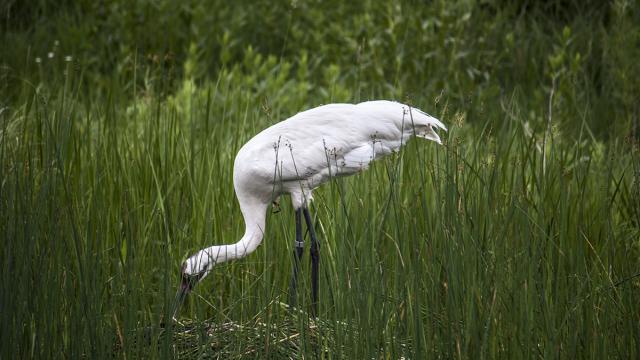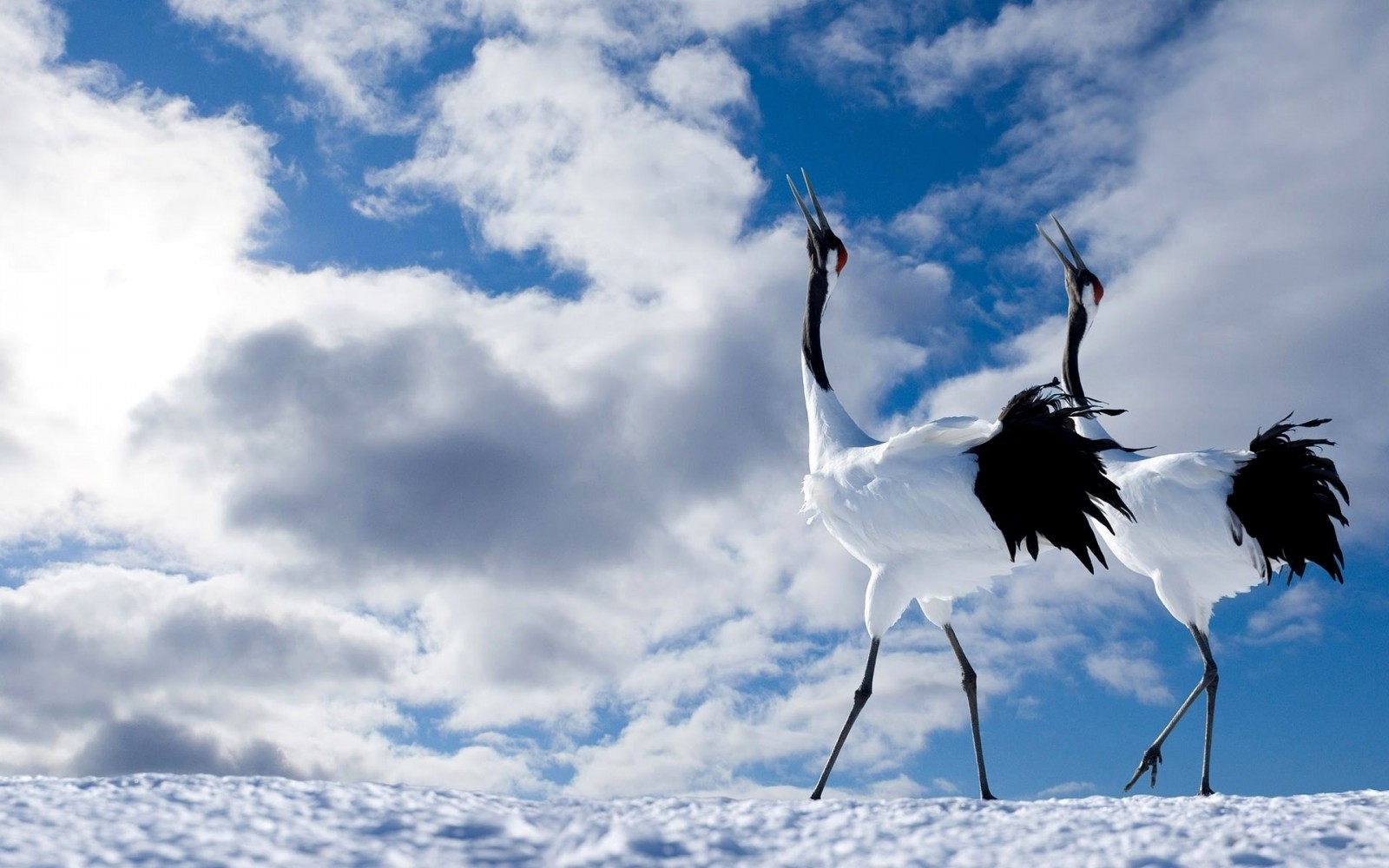
At the International Crane Foundation In Baraboo, Wisconsin, an African crane with a decorative head full of feathers struts alongside the fence surrounding her exhibit, walking majestically for a group of men passing by. Danielle Bunch, a former ICF intern, tells me that she's a lot like human females — she likes to show off for men, but gets aggressive and territorial around human women.
The building she just came out of has a roof covered in solar panels, of which ICF draws 30% of its electricity. At the Whooping Crane exhibit, one bird gingerly drinks water inside the exhibit while its mate makes a warning call to someone who got too close to the fence. The Whooping Cranes are the rarest species of crane — in the 1950s, there were only 21 left in the world. The population has somewhat recovered thanks to the efforts of organizations like the ICF, though the species itself is still endangered.
"Cranes could be the next mascot for the climate change movement, like polar bears," ICF president Richard Beilfuss told me at ICF's "Evening With the Cranes" public fundraiser. "Saving cranes may seem to be a narrow focus, but it's tied to big stuff."
The big stuff that cranes are tied to is the Earth's rapid rate of warming. We've already passed the benchmark of 400 parts per million (ppm) of CO2 in the atmosphere, which is higher than atmospheric CO2 concentration has ever been in 3 million years. As President Obama announces his agenda to tackle climate change, many parts of the world are already seeing massive changes in how they grow food, and many native species are moving rapidly toward extinction.
The UN estimates that between 150 to 200 species of plant, mammal, bird and insect species go extinct every 24 hours — surpassing the rate of extinction the dinosaurs faced 65 million years ago.
One reason the cranes are directly tied to climate change is their wetlands habitat, which erratic weather patterns and dwindling water supplies are endangering all over the world. The Whooping Crane flies a migratory pattern all the way down to a national wildlife reserve in southern Texas, which has suffered crippling droughts in recent years. Beilfuss said a major reason cranes are endangered around the world is because of water allocation due to man-made projects, like hydroelectric power dams and the re-routing of water supplies away from native habitats and toward crop irrigation.
"We need to adopt a more holistic view of water as a whole," Beilfuss said. "A big part of what we're doing in Africa and East Asia is fostering conservation-friendly livelihoods."
One frequent criticism of alleviating climate change is the potential for hampering economic growth in an already fragile global economy. But ICF has found hyper-local solutions for both preserving biodiversity and enriching local economies. ICF helps communities restore wetlands and plant things like Papyrus trees and other versatile crops that indigenous people can use to make crafts like woven baskets. They can then sell these goods to a worldwide consumer base and make enough money to feed their families.
Through projects like these, 21 hectares of African wetlands have been restored in the Grey-Crowned Crane's native habitats in Uganda. 400 people in one Vietnam community are now able to draw their livelihood directly from restoring wetlands in the Mekong Delta. ICF East Asia Director Jim Harris said it was a rapid change for the better, for both the cranes and the people.
"The Leipironia plant we helped grow can be used by cranes and people, for food and livelihood, respectively," Harris said. "Before that, almost all of the Mekong wetlands were used exclusively for agriculture. There was no place for cranes."
Harris conceded that these new conservation-friendly livelihoods at the local level could be called "green jobs," or ways people can make a living by actively aiding the environment. Green Party Presidential Candidate Jill Stein proposed an economic platform relying on green jobs called the Green New Deal (full disclosure: I worked on the Stein campaign in 2012) involving a vast federally-funded program aimed at upgrading the nation's energy and transportation infrastructure to be environmentally sustainable. Harris said those are nice ideas, but solutions have to first come from the local level.
"If we wait for the federal government to act, nothing will ever get done. And we'll unfortunately need to have several more disasters like Hurricane Sandy before people start taking action at that level."
However, small businesses are leading the way at the local level and setting an example for future businesses. According to the 2013 Small Business Sustainability Report, "The Big Green Opportunity," being environmentally-sustainable is proving to be more profitable by an order of magnitude. In the decade from 2001 to 2011, the US organic food market grew by 238%, while the non-organic market only grew by 33% in the same window. Essentially, the greener you are, the more of a market share you capture. It could be said that green is no longer an "alternative," but a mainstream idea as more companies are using "operational efficiency" to both save money and reduce their carbon footprint in the long term.
At the Midwest Renewable Energy Association's (MREA) renewable energy fair in Custer, Wis., coordinator Ellie Jackson told me she sees hope in community development initiatives that produce self-sustaining energy without relying on coal or natural gas.
"We have the means to do it, and people need to know it's widely accessible," Jackson said. "There need to be [tax] incentives for people to install wind and solar on their homes."
Jackson said the 2012 MREA fair involved a workshop teaching people how to implement solar energy at the community level, and Michigan residents who attended were then inspired to take action. This white paper explains the new Community Renewable Energy Program for Michigan inspired by the workshop at the MREA fair. In that study, research shows that communities that implement renewable energy solutions for homes can simultaneously reduce their carbon footprint at a drastic rate while saving collectively millions of dollars in meter costs over time.
"Responses [to climate change] need to address root problems of climate change like energy consumption, not just individual symptoms," Jim Harris of ICF said. "Solutions will depend on addressing the whole watershed of a region."
While it's encouraging to see President Obama take action on climate change, we have to be ahead of the federal government and find ways to generate our own power, run our businesses sustainably, and conserve natural resources and biodiversity if we're to survive extinction as a species in the next century and beyond. A quote is emblazoned on a plaque at the ICF that sums up this critical moment for our planet.
"When the last individual of a core of living things breathes no more, another heaven and another Earth must pass before such a one can be again." — William Beebe, 1906
3 WAYS TO SHOW YOUR SUPPORT
- Log in to post comments















